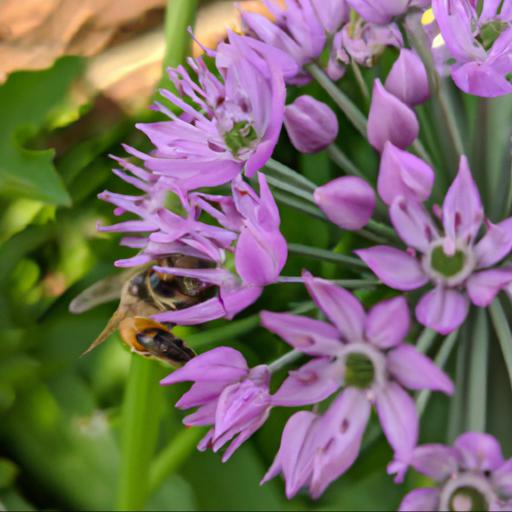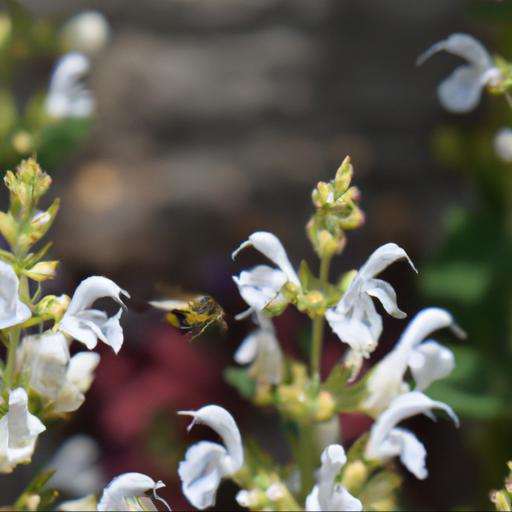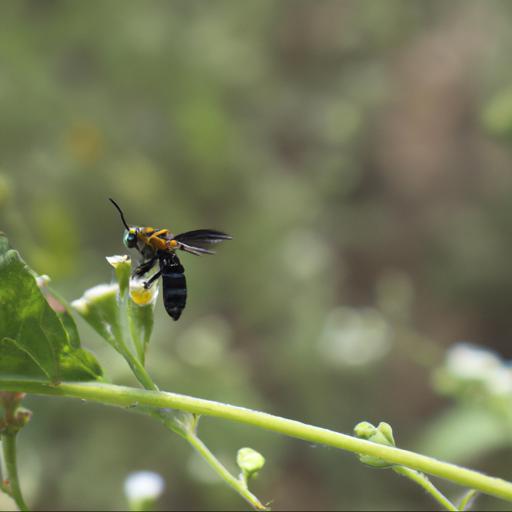Are you looking for ways to increase the number of bees in your garden? Did you know that there are seven distinct types of garden bees? From solitary bees to bumblebees, each species provides different benefits to your garden.
Learn more about the seven types of garden bees and how they can help you create a more vibrant and productive outdoor space.
Overview of the different types of garden bees

Garden bees play an integral part in making our gardens bloom with their sublime pollinating abilities, but not all garden bees are the same. From solitary to group working species, there are seven distinct types of bee that grace our gardens and it’s important to note that not all of these bees live in hives.
In this section, we will take a deeper dive into the different types of garden bee that can be found in the UK countryside. The first type of garden bee is the bumblebee, the most common species found in British gardens. Larger than their honey bee counterparts, bumblebees are typically black and yellow in colour with a distinctive buzzy sound.
They are social insects, living in colonies and going out together in search of nectar and pollen. Bumblebees play an essential role in our pollinating garden flowers such as tomatoes, squash and flowering herbs like lavender and rosemary.
The second type of garden bee is the honeybee. Highly domesticated, bees of this species nest in hives, but their foraging can still be seen in many domestic gardens; a sure sign of a healthy environment. Honeybees collect nectar and pollen to bring back to the hive which is then used to create honey.
A single worker honeybee can make up to ten trips a day so they are highly efficient pollinators! The third type of garden bee found in the UK is the solitary bee. Unlike bumblebees and honeybees, these bees are solitary creatures and do not live in large colonies together.
Solitary bees have special nesting habits, preferring to bury in wood, crevices and holes, or right into the walls of our homes. Despite their solitary nature, they are still incredibly important pollinators as they are typically more efficient at collecting nectar and pollen than their social counterparts.
In addition to solitary bees, there are also four other species of garden bee you will encounter when exploring your British countryside. These species include cuckoo bees, mason bees, leaf-cutter bees, and carpenter bees, all of which share a unique and fascinating biology that makes them worthy of recognition. With their intricate details and unique foraging habits, all seven of the garden bee species should be celebrated for all the hard work they do to make our gardens beautiful.
Benefits of having garden bees

If you’re a UK gardener looking to attract bees to your garden, then having various types of garden bees can bring many benefits. It’s essential to understand the seven distinct types of bees – Bumblebees, solitary bees, mason bees, leafcutter bees, honey bees, hoverflies, and carpenter bees – and how each one contributes to your green space’s biodiversity. Bumblebees are social bees and one of the most obvious types of garden bees you’ll spot in the UK.
Those large, furry indigo and black bodies will buzz from one blossom to another as they pollinate in summertime. Bumblebee colonies often inhabit nests, mostly in the form of birdhouses or compost heaps, for an ideal environment for raising their young.
Solitary bees, such as mason and leafcutter bees, aren’t social and live alone in small holes, natural crevices, or even in bamboo. You’ll recognize mason bees by their black and red banded abdomens, and they can be seen gathering the clays or sands they use to construct their nests. Meanwhile, when we look at leafcutter bees, they are extremely efficient pollinators, carrying bits of leaves back to their nests and building six-sided cells to lay their eggs in.
Honey bees and carpenter bees are also distinct types of garden bees. Honey bees, which are protected by law in the UK, readily form large colonies on any number of substrates, including manmade beehives.
They are brilliant pollinators, and the resulting honey is a highly sought-after commodity and an appreciated reward for your efforts. Meanwhile, carpenter bees nest in wood, and drilling perfect 1/4” round holes, thus releasing a distinct sound of buzzing.
Finally, hoverflies are often confused with bees, but they’re actually flies with bee-like behavior as they flit from flower to flower. They are especially beneficial garden companions because their larvae feed on aphids and other soft-bodied insects that can do damage to your plants. Having garden bees of all types will no doubt enhance the beauty and health of your garden and the local environment.
Each of these species has their own particular value and function, so if you’re looking to attract the pollinators that bring life to your garden, you’ll want to be sure to welcome all seven types of garden bees.
How to attract garden bees to your garden

As a UK garden expert, I understand how important it is to create a bee-friendly garden. Bees are essential for the health of our environment and help to pollinate a variety of gardens and crops, making them some of the most important garden creatures.
To ensure that your garden benefits from these much-needed creatures, there are seven types of garden bee you’ll want to encourage to your space. First, the attractive buff tailed bumblebee has a rather bumpy, fur-like and round body, usually covered in black and orange stripes. Bumblebees are important pollinators and can be seen foraging on lavender, foxglove and scabious.
To attract them to your garden, consider planting beautiful flowers that are rich in nectar and pollen, such as crocuses and alfalfa. Next, the honey bee is one of the most well known types of garden bee.
Honey bees are important for transferring pollen between flowers, which helps in the production of fruits, nuts, and seeds. These medium-sized bees are covered in hairs and have various shades of orange, white and black stripes. To attract them to your garden, try planting large clusters of flowers, such as meadowsweet, rosemary and bugleweed.
And lastly, the larger-than-life red-tailed bumblebee has a furry, redtailed bottom and black and yellow stripes. These bees love sweet clover, a flowering plant that’s essential for creating a source of pollen and nectar for them.
Red-tailed bumblebees are significantly larger than other bees, and can be heard humming as they forage on flowers. As well as sweet clover, yellow-flowered plants make a great planting choice for drawing red-tailed bumblebees to your garden. By planting these seven types of garden bees, you’ll be doing your bit to help pollinate your garden and the environment.
With the right approach to bee-friendly gardening, you will be able to provide the perfect environment for these important garden creatures.
Tips for keeping garden bees healthy and happy
As a UK garden expert, I would like to share with you some tips on how to keep your garden bees healthy and happy. Garden bees are a necessity for our gardens, providing essential pollination services that help ensure a plentiful bounty of vegetables, fruits and flowers.
There are seven main types of garden bees, all of which have their own specialized niche in the garden, but it’s important to provide the right environment for them to thrive. One of the most important things you can do is to create a safe and diverse bee habitat. A good bee garden will contain a variety of habitats including plants that bloom at different times of the year and different types of soil.
This maximizes the chances of providing the flowers, nesting sites and food sources that the different types of garden bees require. In addition, it is important to provide a clean and safe source of water, such as a shallow dish filled with stones, or a bird bath, or a small pond or fountain, to keep garden bees hydrated. Finally, you should try and reduce the use of pesticides to avoid exposing garden bees to potentially harmful chemicals.
There are numerous organic and environmentally friendly pest control options that can provide the same level of protection without putting the health of your bees at risk. If you need to apply synthetic pesticides, do so very selectively and only after consulting a specialist.
Be sure to carefully follow all instructions on labels and avoid spraying blossoms when possible. These are just a few of the tips for keeping garden bees healthy and happy.
By taking the time to create a safe and diverse bee habitat, to provide water sources, and to reduce the use of pesticides, you will ensure the well-being of your beloved garden bees and be rewarded with a bountiful harvest for years to come.
Conclusion
This article has explored the seven types of garden bees, their roles in pollination, and the benefits they bring to gardens. Bees are essential to the health of the planet, and gardening can be a great way to support them.
By understanding the different types of garden bees, gardeners can create a welcoming environment for these important pollinators. With careful planning and thoughtful planting, gardeners can enjoy the beauty of garden bees as they help to create a thriving garden ecosystem.
FAQ
What are the seven types of garden bees?
The seven types of garden bees are bumblebees, honeybees, mason bees, leafcutter bees, carpenter bees, sweat bees, and mining bees.
What are the characteristics of garden bees?
Garden bees are typically small, solitary bees that are important pollinators. They are usually black or brown in color, and have hairy bodies that help them collect pollen. They are active during the day and prefer to feed on flowers with open centers. They are also typically non-aggressive and rarely sting.
How do garden bees benefit the environment?
Garden bees help to pollinate plants, which helps to increase the biodiversity of the environment. They also help to produce honey, which can be used as a natural sweetener. Finally, they provide a food source for other animals, such as birds and bats.
What plants do garden bees prefer?
Garden bees prefer flowers with easily accessible nectar and pollen, such as daisies, lavender, and clover.
How can I attract garden bees to my garden?
To attract garden bees to your garden, plant a variety of flowers that bloom at different times throughout the season, provide a shallow source of water, and avoid using pesticides.
What are the dangers of garden bees?
The main danger of garden bees is the potential for a bee sting. Bee stings can cause pain, swelling, and in some cases, an allergic reaction that can be life-threatening. Additionally, bees can become aggressive if they feel threatened, so it is important to be cautious when working in the garden.

